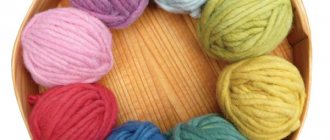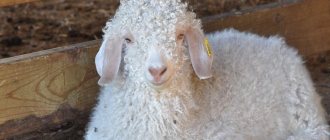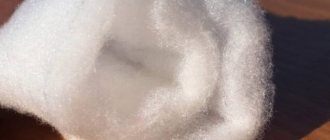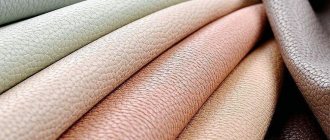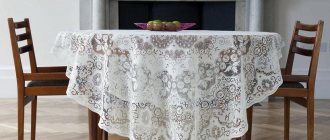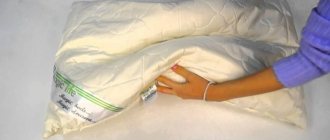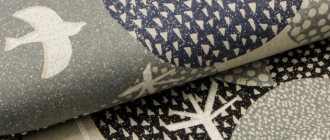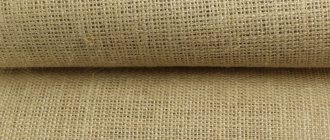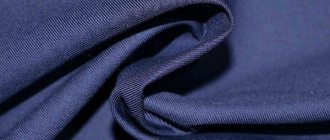What is wool fur?
Wool is the hair of an animal, consisting of coarse thick and downy fine hair. Coarse hair is designed to perform a protective function and create volume, determine appearance, while fine downy hair maintains body temperature. Thanks to the air layer created by the wool, the animal does not freeze or overheat.
Animals are “suppliers” of wool
By analogy with human hair, it contains a special protein - keratin. The base is in the follicle, which is located in the deep layer of skin called the dermis. The difference is that in humans one hair grows from each follicle, while in animals two hairs grow: downy hair and guard hair.
Sheep's wool
Biological composition and structure of wool
Wool is the hair of animals. It consists of long straight or wavy hairs and thin short, softer and crimped hairs. The first is wool, the second is fluff. These are types of wool fibers.
I remember the riddle familiar from childhood: “A fur coat and a caftan walk across the mountains and across the valleys.” This is a sheep. It is sheep that provide the bulk of the wool processed in the Russian textile industry. The bulk of wool (94-96%) for textile industry enterprises is supplied by sheep farming.
Wool fibers are used to make dresses, suit and coat fabrics. The fiber can be spun, yarn can be spun into cloth, and knitted; you can felt woolen fleece - hence the words felt boots, felt. Finely felted wool is used to make cloth, drape, felt, felt and other textile fibers.
Wool is the hair of sheep, goats, camels and other animals. The bulk of wool (94-96%) for textile industry enterprises is supplied by sheep farming.
Wool removed from sheep is usually very dirty and, moreover, very uneven in quality. Therefore, before sending wool to a textile factory, it is subjected to primary processing. Primary processing of wool includes the following processes: sorting by quality, loosening and scuffing, washing, drying and baling. Sheep wool consists of four types of fibers: a) fluff - very thin, crimped, soft and durable fiber, round in cross section; b) transitional hair - thicker and coarser fiber than fluff; c) awn - a fiber that is stiffer than transitional hair; d) dead hair - very thick in diameter and coarse, uncrimped fiber, covered with large lamellar scales.
Guard, or integumentary, hairs are long, have a well-developed straight or slightly curved shaft with a scaly structure. Slightly thickened towards the middle. The top of the hair is a cone. Guard hairs are divided into hairs of order I, II, III and sometimes IV, depending on thickness. The thickest and longest hairs are called guides. They are located more sparsely, and their ends protrude above the total mass of hair. The structure of the guard hairs determines the waviness and structure of the coat. The straighter and stronger they are, the less wavy the coat is. Often the guard hair has its own muscle - the levator, sweat and sebaceous glands. The outer hair performs, first of all, a protective function, retaining heat and protecting the skin from injury. In many species of animals, the fur has a camouflage coloring, which is very important for survival, allowing the animals to be inconspicuous against the background of the environment (for example, the white hare and the polar bear).
Downy hair (undercoat) is shorter, finer, usually wavy, curved hair with no core or poorly developed core. They serve to more effectively retain heat in the coat. In many animal species, they appear in large numbers only during the cold season.
There are also intermediate hairs that occupy a position between downy and guard hairs.
Wool that consists predominantly of one type of fiber (down, transitional hair) is called homogeneous. Wool containing fibers of all these types is called heterogeneous. A special feature of wool is its ability to felt, which is explained by the presence of a scaly layer on its surface, significant crimp and softness of the fibers.
Properties of wool (mechanical, physical, technological).
Wool is resilient, elastic, strong, and has a crimped fiber (the finer the wool, the more crimped it is). Crimping helps to obtain loose, fluffy and elastic yarn, as well as increasing the wear life of products. Thanks to their good elasticity, woolen products do not wrinkle and retain their good appearance for a long time.
Wool is hygroscopic, meaning it can absorb water. At high humidity, it can absorb up to 33% of moisture relative to its own weight without being wet to the touch and slowly releases it into the environment.
Wool has great heat insulation.
Wool's thermal conductivity is lower than that of many textile fibers. This is why wool bedding is the warmest.
Good drape of some types of wool fabrics.
The main substance that wool consists of: keratin - belongs to the group of protein (protein) substances.
2. 1. Healthy wool.
People learned about the beneficial properties of sheep skin and wool a long time ago. One of these properties is the content of lanolin in sheep fleece, a substance found in many creams and ointments. Lanolin not only nourishes and softens the skin, it also has anti-inflammatory, anti-edematous, anti-allergic effects, and promotes the absorption of medicinal substances from ointments, which it contains as a base. But few people know that lanolin is obtained from the rinsing waters of sheep wool. Another unique property of sheep wool is its ability to absorb moisture in an amount equal to 33% of its evaporation. In exchange for absorbing moisture, wool produces heat, thereby improving blood circulation. And the human body under it always remains dry and warm. Even cotton, the products from which children wear, and we adults try to wear, absorbs only 8% of moisture. Artificial fiber does not absorb moisture at all and does not evaporate it.
Nature has endowed sheep's wool with another positive property: its fibers are securely attached to the skin of sheep. Tanning leather locks the fibers even tighter, making sheepskin soft and flexible. Despite frequent washing of sheepskin products, the fibers remain securely attached to them. Sheepskin products - carpets, rugs, bedding and other things - are tried to be made from the skins of unshorn sheep, so they are very soft and silky. And what an extraordinary, positive, psychological and energetic effect products made from sheep skins and wool have on an adult or child. They create a feeling of comfort, calm, joy.
Sheep wool has a beneficial effect on human health. For example, in New Zealand it is used to care for premature babies. A premature baby is born immature, retains heat poorly, and slowly increases body weight. If such a child is kept in an envelope - an incubator made of sheep wool, and not in cotton blankets or flannel diapers, he matures much faster, does not lose heat, and always remains dry. In addition, it was noticed that such a baby is less likely to suffer from viral and bacterial infections, especially pustular skin diseases.
Up to three months of age, infants often suffer from abdominal pain due to excess gas production. If your baby is fussy and crying, place a pad or clean sheep's wool on his stomach all day or all night.
It will warm you up, improve blood circulation, relieve pain - and the child will calm down. In case of an unfavorable pregnancy and difficult childbirth, a child may be born with encephalopathy, which is accompanied by a syndrome of increased neuro-reflex excitability, muscular dystonia and other disorders. Due to increased intracranial pressure, such children suffer from severe headaches, are restless, sleep poorly, and eat little. And in this situation, sheep wool can help. Make a ribbon 5-7 cm wide from sheep's wool and tie the baby's head along the brow ridges around the head. It is even better to place the child on a sheep's wool mattress or wrap in sheep's skin for 10-12 hours. It is also good to put the baby in sheepskin envelopes to sleep. The result exceeds all expectations: the baby quickly calms down due to warmth, decreased intracranial pressure, improved general blood circulation and microcirculation, as well as decreased muscle tone.
In autumn and spring, people are especially susceptible to viral infections. If you are sick, do not forget to include sheep wool in your treatment complex. Its use for pneumonia gives very good results. A sheepskin “sleeve jacket” is put on the naked body, which is worn both day and night. This “shower” is much more effective than mustard plasters, cupping or rubbing in resolving foci of inflammation.
Sheep wool will provide an invaluable service for diseases such as otitis media and sinusitis. Submandibular lymphadenitis. Dry sheep wool compresses applied to the ear area, maxillary sinuses (under the eyes on either side of the nose) or enlarged lymph nodes under the jaw and neck help relieve pain and reduce inflammation. Such compresses can prevent the development of purulent otitis and sinusitis, stopping them at the stage of catarrhal inflammation. It is only necessary to catch the earliest signs of the disease.
Diseases such as rheumatism, rheumatoid arthritis, metabolic arthritis, post-traumatic arthritis are accompanied by joint pain, limited mobility, and swelling. In these cases, it is useful to wrap the joints (elbows, knees, ankles) with sheep's wool.
Even in ancient times, people got rid of toothache and headaches by wrapping their heads in a woolen scarf.
Woolen products are especially recommended for people suffering from radiculitis or rheumatism. Radiculitis is a disease associated with the spine. People suffering from radiculitis are contraindicated to sleep on a down bed. At night, the body temperature drops slightly, and a person, trying to warm up, wraps himself in a blanket, but throws it off after a while, as he becomes too hot. A wet body instantly becomes hypothermic and in the morning we are no longer able to turn our necks or stretch ourselves. This happens because the body, which needs dry heat, does not receive it under a duvet that does not allow air to pass through. Wool absorbs moisture, allows the body to breathe and neutralizes harmful substances that the skin releases with sweat.
Due to the fact that the wool from which our products are made is not treated with chemicals and dyes, it retains its biological properties and lanolin, which is so beneficial to health.
Along with rheumatism, woolen products are also recommended for people suffering from:
— osteochondrosis;
— orthopedic diseases;
- allergies;
— asthmatic (bronchial) diseases;
- circulatory disorders.
During the night, a sleeping person loses from half to a whole liter of moisture through sweating. Wool absorbs moisture seven times faster than any other textile fiber, keeping your body dry and warm.
Thanks to its special properties, similar to those of human skin, wool maintains the climatic conditions that are necessary for the body. It is not for nothing that the sons of the desert, from the time of Muhammad to this day, wear burnouses made of wool, which protect their heads from the scorching sun during the day and from the cold at night.
Already a century ago, the famous researcher of the properties of wool, Professor Yeager, established that wool can neutralize skin fumes. Today's sleep hygiene research can confirm that sheep's wool, sheared from a living animal, neutralizes toxic substances.
Under normal conditions, wool is weakly electrified and does not retain dust particles. Despite its scaly structure and natural curliness, wool is a smooth fiber. Wool repels water and other liquids. Due to the large volume of air contained in wool, water and detergents easily pass through it and dissolve dirt.
The undeniable advantages of wool include the following:
- wool allows the body to breathe;
— wool neutralizes toxic substances released along with human sweat;
- wool keeps the body dry and warm;
- wool is elastic;
- wool tends to remain clean.
Sheep wool, along with massage and therapeutic exercises, is an excellent means of rehabilitation after fractures, when the plaster has already been removed. It promotes pain relief and a rapid increase in mobility of the injured area of the body. It also brings great relief to radiculitis.
Hippocrates also proposed nursing seriously ill patients on animal skins. This method is still used in many countries. In New York State, doctors observed for ten months in one of the hospitals seriously ill patients with bedsores who were nursed on sheep wool. Thanks to its unique properties of removing excess moisture and evaporating it, as well as lubricating the skin with lanolin contained in wool, the influence of the three main causes of bedsores - pressure, friction and moisture - is significantly reduced. With any long-term disease, the electrical potential in the human body is disrupted. It is not leveled by any known drug. Sheep wool has a unique ability to smooth it out, which speeds up recovery.
Everyone knows how much children love to play on the floor. In these cases, there can be no better rug than a sheepskin rug. When playing on such a rug, children quickly calm down, stop being capricious, and do not quarrel over toys. And what is also very important is that after playing on a sheepskin rug they remain calm for a long time. There is always a close connection between mother and child. It arises still inside the womb. Immediately after the birth of the baby, this connection cannot be interrupted, otherwise the child will experience stress. Therefore, now in many maternity hospitals they try to take him to the mother as soon as the child is born. But if for some reason this is impossible to do, then it is advisable to wrap the child not in cotton diapers, but in sheep’s wool. And researchers at the University of Cambridge have proven that sheep's wool in such cases significantly reduces postpartum stress in infants.
To improve your well-being, it is useful to acquire rugs, pillows, bedding, bedspreads, and mattresses made of sheep wool. For example, place a small piece of sheep's wool on your favorite chair or on the floor under your feet. It will not only warm you up every day, but also make you feel lighter. If you are planning to decorate your interior with a rug or get a new pillow, blanket, buy knitted socks or slippers, choose those made from sheep wool. You can't go wrong.
2. 2. Healing properties of sheep skins.
The beneficial effects of sheep skins have been known to the body since ancient times. For thousands of years, animal skins played a huge role in human life - they were used to make clothes, shoes, housing, armor, utensils, and later they served as a monetary unit. Without chemical preparations, ancient man experimentally found various options for tanning leather using “environmentally friendly” methods. Modern man, alienated from nature, rediscovers them for himself. Sheep skins have special energy and have a healing effect on the human body and soul. The friction of wool fibers against each other creates an electrostatic field, which has a good effect on health and mood. Fatigue, aching joints, and muscle pain disappear. Sheep wool relieves pain from radiculitis, arthritis and other diseases. It maintains natural body temperature.
Products made from sheep skins relieve stress, restore and normalize blood pressure and sleep, and serve as a prevention of chronic diseases. Sheep wool has a therapeutic and preventive effect on diseases of the spine and joints. Dry compresses made from sheep wool help in the treatment of otitis media, sinusitis, and lymphadenitis.
Natural furs have a strong biofield. Since ancient times it has been known that natural fur is an excellent protection against diseases. It is not for nothing that our ancestors placed sheep or mutton skin in the cradle of a newborn so that their fur touched the child’s body. From ancient times to the present day, methods of treating chronic diseases using sheep skin have been preserved. Faux furs, unfortunately, do not have such properties.
Sheep wool contains lanolin (animal wax), which has anti-inflammatory, anti-edematous and anti-allergic effects, which accelerates the healing of wounds and fractures, beneficially affecting the process of restoration of damaged tissue. Lanolin is obtained from the rinsing waters of sheep's wool.
Sheep wool promotes rapid restoration of mobility in fractures after removal of the plaster, and has an analgesic effect.
The use of sheep wool for pneumonia gives very good results. Clothes made of fur or wool are worn on the naked body (fur inside). Sheep fur effectively resolves inflammation.
Sheep fur does not irritate the skin and does not cause allergies - a disease of our civilization. Already 100 years ago, people knew that natural wool can neutralize toxins released in sweat by binding them to organic molecules.
Hippocrates advised nursing seriously ill patients on animal skins, preferring sheep's wool. Skins are widely used in folk medicine. Currently, the prerequisites have been created for the use of this ancient method at a new modern level.
Since ancient times, sheep skin has been used to care for premature babies. This tradition still exists among the aborigines of New Zealand and Australia. Modern research has confirmed that sheepskin is not only comfortable, but also useful for children, both in winter and summer. The baby laid on it quickly calms down. Thanks to the correct natural arrangement of the fur, natural air circulation occurs, which protects the child’s skin from sweating and drying out. Sheep wool does not contain microorganisms that can have a harmful allergenic effect on the child. The tests carried out prove the comfort and safety of products made from lamb skin; babies quickly get used to them and sleep longer and more peacefully. Lanolin contained in sheep wool has a beneficial effect on the skin and prevents dermatitis. The soft fur provides a constant light but effective massage.
A premature baby is born immature, does not retain heat well, slowly increases body weight, if such a child is kept in an envelope - an incubator made of sheep wool, he matures much faster, does not lose heat, and always remains dry. In addition, such a baby is less likely to suffer from viral and bacterial infections and purulent skin diseases.
Sheep skin warms the child, calms him down, improves blood circulation, and as a result relieves abdominal pain in a child suffering from gas. Normalizes intracranial pressure - the cause of headaches, anxiety, poor sleep and appetite.
It is especially useful to put the baby in sheep wool envelopes at night to sleep - the baby quickly calms down due to warmth, lowering intracranial pressure, improving blood circulation and microcirculation, as well as reducing muscle tone.
The outer surface of wool fibers is resistant to water penetration, and their inner surface has absorbent properties, and, absorbing up to 33% of moisture from its own weight, the woolen product does not seem wet when touched (for example, synthetic fabrics can retain only 2-3% of moisture) . Even with its own minimum weight, a wool product is very warm, since wool fibers have the property of trapping air. Wool absorbs moisture from the environment and releases heat accordingly. The presence of water, plus the protein creatine coating on the fiber, gives wool its natural fire resistance. In addition, wool is unusually elastic, and due to its scaly structure, the fiber remains clean for a long time. Naturally highly curled wool ensures the presence of a dense layer of air in clothing (up to 85% of the total volume). Since the air layer is an excellent insulator, woolen clothing protects the human body from cold and heat. Sheep's wool is germ-free. Bacteriological analyzes in the sheepskin (taking into account that during life the sheep was not a “refuge” for fleas) did not reveal any harmful microorganisms.
Chapter 3. Experimental part.
3. 1. Research methods:
— study of archival materials;
— qualitative reactions to detect lanolin.
a) According to data obtained from archival materials:
For the period from January 1, 1942 to January 1, 1943.
Sheepskin short fur coats and covered fur coats of all types - 408 pcs. , sheepskin coats - 6, leather coats, jackets - 3, hats with ear flaps - 314, fur vests - 45, socks, woolen stockings - 408, woolen mittens - 544, woolen gloves - 14, fur mittens - 61, warm foot wraps - 12, felt boots, combs - 2518, raw sheepskin - 1259, dressed sheepskin - 1992, wool yarn - 6.8 kg and other things. There are 74 titles in total.
b) By means of a qualitative reaction, we conducted an experiment on the fibers of samples taken from the technology room.” fiber - wool" and from fiber brought by grandmother from the village.
Color reactions to fibers.
1. A little sodium hydroxide (NaOH) solution was added to a small amount of fiber and a solution of copper (II) sulfate (CuSO4) was added drop by drop, a red-violet color appears.
2. When exposed to concentrated nitric acid, the fiber turned yellow. This reaction proves that the fiber is natural.
And what's interesting?
It turns out that the sample taken from the technology room was artificial.
Thus, we found out that wool is natural; fiber containing a large amount of lanolin is of higher quality and has better properties. , healing properties.
Conclusions and recommendations based on the results of the research work.
Evolutionary origins of wool
Genetic studies claim that animal hair appeared more than 300 million years ago in the common ancestor of mammals - lizards and birds. In the DNA of modern lizards and chickens, scientists have discovered a gene responsible for the appearance of hair in humans. The first representatives of mammals, which appeared approximately 160 million years ago, had a beautiful “fur coat” thanks to an evolutionary change in keratin, which is the main component of hair.
The answer to the question of what wool is is the following - this is the evolutionary transformation of keratin from the claws of birds and lizards into wool.
On a note! In mammals that lead an underground or underwater lifestyle, fur gradually disappeared. Distant human ancestors lost their cover for more efficient heat transfer, which confirms the human ability to sweat. But numerous animals retained their fur.
Features in different species of mammals
An animal's coat depends on genetics and species. Depending on the composition, the following types are distinguished:
- hairless breeds of animals - hairless breeds of dogs and cats, the most famous among cats is the “hairless” Sphynx;
- animals with double fur - brown bear, squirrel;
- animals without undercoat - deer, wild boars.
Unfortunately, animals with thick fur suffer from lice eaters - permanent parasites of mammals.
Sphynx cat
A little history about the use of animal hair
Distant ancestors knew that wool perfectly protects from the cold. But initially, the entire technology for using animal hair involved skinning them. It was the skin taken from an animal killed during a hunt, along with its wool, that made up the clothing of ancient man.
You might be interested in what is better for bed linen: poplin, satin or calico
As a result of the domestication of wild animals and the development of cattle breeding, new skills emerged - not only animal skins, but also animal hair were used to make warm clothes.
On a note! Mainly sheep, camel and goat. It was cut or combed, and yarn was spun from it - long threads consisting of intertwined hair. Such threads also retained heat, just like animal skins.
The technology for making yarn is simple - a spinning wheel and a spindle. It was with them that modern industry began. Archaeological excavations indicate the use of wool in the manufacture of clothing more than 1500 BC. e. A lot of evidence has been found in the territory of modern Italy, so it is safe to say that the ancient Roman citizens wore woolen tunics with pleasure.
Wool became the subject of profitable trade, and the economies of many countries depended on it. Great Britain has gradually become one of the leading countries in the production and export of woolen fabric.
Since the invention of the method of washing woolen products, they have been in deservedly high demand.
Its use as insulation for leather boots and suede boots is very popular.
Boots with wool inside
Composition and structure
Wool fibers are horny changes in the skin. What does fur look like under high magnification?
Fiber structure:
- The outer layer is protective. The shine and ability to roll depend on the direction and size of the scales.
- The middle layer forms the body of the hair.
- The central part of the fiber, its basis is made up of cells filled with air.
Structure of wool fiber
Depending on the quantitative ratio of individual layers, wool fibers are divided into several types:
- fluff - soft, twisted fiber;
- transitional - harder, thicker than fluff, the core layer is partially present;
- awn - a thick fiber with a core layer;
- dead - a thick fiber, coarse and brittle, the core occupies the main part.
Natural wool has the following properties:
- low thermal conductivity, excellent heat retention;
- strength and wear resistance;
- hygroscopicity;
- dirt resistance;
- low creaseability.
You might be interested in this. Detailed description of Mongolian cashmere from the Gobi factory
Shades of fur in various animals
Real wool has one color, but after washing its intensity and tone may change. The thing is that the wool fiber in the cortical layer has pigment particles, they are not visible at a simple glance, but these pigment grains of black and red colors, when rinsing the wool, influence its final color.
True wool colors
Different animals produce different coat colors. White wool is very expensive. It is particularly soft and can be dyed in any color. But white is still closer to a milky color. It is also sometimes called unbleached. The thing is that real fiber contains sweat and animal fat, which also affect the color of the raw material, even after washing.
The natural colors of this material are, for the most part: gray, brown, black, milky, beige.
Alpaca has a variety of colors, but the shades are mostly black, dark brown, light gray, white and cream. This is a noble thread that comes out, which is well appreciated. In antiquity, it was used to make robes for royalty.
What to wear with black patent leather, suede shoes, with or without heels, tips and tricks
Alpaca
The original animals that give the best fleece are called:
Suri's fur is so soft that it resembles plush. This fiber almost never goes on sale due to its high price.
The raw material obtained from huacaya is the key type of alpaca that can be found at retail outlets.
Lama
Lama produces fleece with special thermal properties; it is not in vain that coats are made from this material. The weight of the raw material is small, but its dense consistency and thermostatic properties make it possible to rate this raw material very highly among various types of fibers.
In addition, llama has healing qualities.
Camel
The fleece obtained from a camel also has healing properties. This material is used to fill blankets, pillows, and make clothes for the home. This material contains lanolin, which, when heated from the surface of the human body, has a relaxing effect, relieving muscle pain. In addition, this material does not attract dust, so that things in everyday life at home made from camel fleece are impeccable. The color of real fiber is beige, light brown.
Yak
The fleece produced by the yak usually has several colors: gray, brown, and dark gray. Thanks to the special construction of the fleece, the products cannot become overheated or overcooled. Some peoples wear clothes made from this fiber both in hot and cold weather.
Goat
Goat fleece has a unique property of retaining heat. It is because of this that cashmere and mohair arose for the animal.
Products made from goat wool are light in weight, but very warm. Goat hair helps with exacerbations of varicose veins, and also relieves pain from sore throat.
Sheep
Sheep wool (merino) has been used since ancient times. Nowadays, they are used to make carpets, fill blankets and pillows, and make rugs. Merino is useful for diseases of the musculoskeletal system and neuralgia. The color of natural fibers can vary from white to beige. Moreover, it can vary in tone, starting from the lightest color, ending with almost brown color. The most valuable sheep fleece is white.
Hare
For the most part Angora hare down , since the wool is too short in pile. The famous angora thread used in making winter knitwear is made from rabbit down. The raw material is excellent for the development of sweaters, hats and mittens.
Angora downy hares
2. Dead and living wool
Dead wool is collected from already killed animals. Very often it is collected at slaughterhouses. And the live ones are cut off from the animals during their life .
Merino sheep shearing
It is believed that only living fleece has the necessary quality; due to the natural coating produced by the animal’s skin, it is endowed with all the necessary characteristics that have a healing effect.
Wool products are, first of all, very high-quality things that can not only burn in severe frosts, but also help with specific ailments. Cashmere, angora, mohair, alpaca - all these wool fiber options are synonymous with excellent quality and long service life.
Types of wool products, their use
According to the method of production, wool is divided into the following types:
- natural - sheared from animals (sheep, goat), combed (camel, dog, goat and rabbit fluff) or collected during the animal’s molt;
- factory - removed from the skin of an animal in production;
- restored - obtained by plucking flaps and scraps of yarn.
Natural is the most valued; it is from it that the best products are made; its qualities are much superior to reconstituted ones.
The composition of the material is of two types: woolen and half-woolen.
Important information! Pure wool fabric is considered to be a material that contains no more than 10% other fibers. It can be natural - cotton, linen or silk, or artificial - viscose, nylon.
According to the method of manufacturing fabric, matter is divided into the following types:
- worsted: made from semi-fine and semi-coarse twisted yarn, the best material for suits and dresses;
- fine cloth: consists of fine machine-made yarn, for coats;
- coarse cloth: consists of coarse yarn; overcoat cloth, felt, and felt boots are made.
Overcoat gray cloth
Woolen textiles are used for sewing various products - from coats and suits to bedding and thermal underwear. The range of fabrics is very wide:
- rep - thick suit material;
- gabardine - dense but light coat and raincoat fabric;
- bouclé fabric - thick suiting fabric with knots on the surface;
- jersey is a type of knitted material for dresses;
- velor - with pile, used in furniture upholstery, for sewing jackets and blazers, as well as for elegant holiday dresses;
- flannelette - with one-sided fleece, used for blankets;
- cloth - very dense and heavy fabric for outerwear;
- flannel - soft, thin, brushed, used for making diapers, baby undershirts and bed linen;
- tweed - soft material for demi-season coats;
- plaid - a soft thin material, the pattern is always checkered, used for sewing men's shirts and women's dresses;
- drape - heavy, dense material for a coat;
- cashmere is a dense material for coats, stoles, cardigans, pullovers, scarves, and is very expensive;
- felt - made by felting, used for sewing shoes and children's toys.
Important information! The seasoning used to dye fabrics is sumac. The result is green to brown colors that are resistant to water.
You might be interested in Features of the creation and use of goat hair and fur
Sumac seasoning for wool dyeing
Types of elite wool
Cashmere is the most expensive of all wool materials. The fabric is made from the combed undercoat of a cashmere goat. Cashmere threads are several times thinner than human hair, delicate fabric, hypoallergenic.
Delicate thin cashmere
Alpaca is an exceptionally warm wool of a rare variety of llama, warmer than sheep. To obtain wool, they are shorn once a year. The wool does not mat, does not mat and does not cause allergies.
Alpaca delicate color
Angora is the down of the Angora rabbit, which is quite short. Most often, angora is used in mixed fabrics. Wool cannot be washed. Cleaning only in special dry cleaners.
Angora
Merino is wool from the withers of a Merino sheep. Very long and soft fiber. Most often mixed with cheaper raw materials.
Merino caramel color
Camel - the downy undercoat of a camel, light and silky. It is not painted, the colors are only natural. The dry heat of wool performs a useful function and is used for medicinal purposes.
Camel wool fabric
Mohair is the wool of Angora goats that has a natural shine. Surprisingly strong and at the same time silky fiber. Can be painted well.
Mohair jumper
Llama - the undercoat of the llama is used in the manufacture of elite material. For each product, the wool of a specific subspecies of llamas is selected. Can be washed in cold water by completely submerging.
Llama wool fabric
Important information! To make sure when choosing a material whether it is wool or not, you can conduct a small test: set fire to a few threads. Natural wool will flare up quickly, but does not burn immediately, slowly turning into ash. The burnt ball can be ground into powder.
WOOL
WOOL, 1) the hair of mammals, which has spinning properties and feltability. 2) One of the main. natural textile fibers, raw materials for the wool processing industry. Basic The mass of wool (95%) processed by the industry is sheep wool; much less is obtained from goats, camels, rabbits, llamas, yaks (Sarlychya wool), alpacas and other animals. According to FAO, in 2013 the production of sheep wool (in thousand tons): in the world - 2126.9, in Asia - 950.2, Africa - 238.3, Europe - 265.8, America - 147, 1; leaders in its production: China - 471.1, Australia - 360.5, New Zealand - 165.0. In the Russian Federation in 2015, 55.6 thousand tons of sheep wool were produced.
Depending on the method of obtaining wool, it can be: natural (sheared from live sheep - the most valuable; molt wool - collected from cows, horses and other animals when they shed in the spring; combed - camel, dog, sarly, as well as goat fluff and rabbit); factory - from the skins of killed animals in tanneries (obtained using chemicals, steaming, etc., which deteriorates the quality of the steel). Shearling from sheepskins (sheepskin shearing) and old wool, restored - regenerated (obtained by processing and splitting old woolen items) is used for the production of woolen fabrics of poorer quality - vigoni.
Hair fibers are a derivative of the skin and consist of protein compounds such as keratin (see Hair). In appearance and technical. According to their properties, wool fiber types are distinguished: fluff (the most valuable fiber with a fineness of up to 25 microns), guard fiber (52–75 microns), transitional (30–52 microns; the wool of semi-fine wool and some semi-coarse wool sheep consists entirely of such fiber); types of guards are dead (almost straight, brittle, weak to tear, very coarse guard fibers, 75–240 microns), dry hair (coarse and dry spine), covering, protective, tactile. hair, etc. Hair fibers of all types consist of scaly (cuticle is a thin protective shell of keratinized cells 0.5–2 microns thick; affects shine and rolliness) and cortical (provides strength, elasticity, extensibility and other properties of hair). ; in this layer there are granules of the melanin pigment), and in the transitional fibers, awn, dry, dead and covering hair there is also a core layer (a cavity inside the fiber, solid or porous, filled with dried cells and air; the more developed this layer, the lower technological properties of Sh.).
Phys. properties of wool: fineness (the cross-sectional value of the fiber in microns), crimp (the number of twists per unit length of fiber), length (natural and true), strength, elongation, elasticity, elasticity, hygroscopicity, color and shine. The crimp of the fibers gives them a complementary feel. elasticity.
Based on the composition of the fibers that form it, sheep wool is divided into homogeneous and heterogeneous. Homogeneous wool consists of downy and transitional fibers that are identical in appearance, length, fineness, and other properties, which, when combined into groups, form staples (transitional fibers of wool from long-wool sheep form homogeneous braids). Staples or braids are elements of the fleece. Homogeneous fibers include thin, semi-fine and semi-coarse wool, the fineness of the fibers of fine wool is up to 25 microns, semi-fine – 25.1–31.0 microns, semi-coarse – 31.1–40.0 microns. Heterogeneous hair is a mixture of spine, down, and transitional fibers combined into braids; it is divided into semi-coarse and coarse.
In fine-fleece sheep, the width is the shortest - 6–9 cm, and in semi-fine-fleece sheep - 10–15 cm; the longest width is in long-wooled meat sheep (Lincoln breed, etc.) and some coarse-wooled ones (Gissar breed, etc.) - up to 40 cm or more. Basic The colors of the hair (white, black, red, and gray) are due to the presence of melanin pigment grains in the cells of the cortical layer of the hair fibers. The most valuable white sh., it can be painted in any color. Gloss—the ability of a wall to reflect rays of light—depends on the structure of the scaly layer and the degree of development of the core layer. The strongest shine - luster - is found in sheep of the Lincoln, Russian Longhair, etc. breeds. Semi-luster shine is found in sheep of the Romney-Marsh and Kuibyshev breeds. A silvery sheen is characteristic of the wool of fine-wool and semi-fine-wool sheep, a matte sheen is characteristic of the wool of coarse-wool sheep and especially of wool containing a lot of dead hair. Fabrics made from wool with a low sheen have a worse presentation. Sheep wool is used for the production of various. fabrics, knitwear, carpets, felt products.
Goat hair is divided into homogeneous and heterogeneous. Goats of the Angora and Soviet wool breeds produce a homogeneous wool - moger (mohair, angora), consisting of transitional fibers, with great elasticity and strength, and a strong luster shine. Moger is used in the manufacture of velvet, plush, blankets, rugs, carpets, drapery and other fabrics. Products made from moger are highly durable.
Camel wool is heterogeneous, from white to dark brown in color, characterized by increased gloss, high strength and elasticity, and low feltability. Used to make high-quality blankets, rugs, and knitwear. The hair of llamas, guanacos, alpaca, and vicuña is heterogeneous and is similar in properties to the hair of goats and camels. Yakov wool is heterogeneous, used in the production of cloth. Rabbit and hare wool, distinguished by its fineness, good elasticity and feltability, is a valuable raw material for the felt industry. Konskaya Sh. is a low quality raw material, used for the production of coarse felts. Cow wool has good feltability and is used in the manufacture of coarse cloth and in the felting industry. Deer hair contains a large amount of dead hair and is used in mattress and furniture production.
Proper care
Wool fabrics are machine washable, subject to the following conditions:
- temperature no more than 30°C;
- delicate “manual” mode;
- zippers must be closed;
- special detergent marked “for wool”;
- do not wring, dry on a flat surface;
- You can iron it through a damp cloth or by setting the appropriate mode on the iron.
When wearing sleeves for a long time, the cuffs are subject to frequent friction. They may become shiny. To get rid of shine, you need to steam the product and rub it with a stiff brush.
Caring for wool products
Important information! Wool products absorb odors well. The aroma of your favorite perfume will linger on your woolen coat. But lovers of cigarette smoke should wear woolen items less often. The tobacco smell does not disappear for a very long time. Only dry cleaning will help you deal with it.
Light industry is improving and keeping up with the times. New technologies are being launched into production, new synthetic materials are appearing. But wool, as a truly natural material, will never go out of fashion.
Wool and its beneficial properties
While preparing my first publication for you, of course, about the benefits of the material from which I make my products - WOOL, I found several wonderful, but not large articles on the Internet, mixed them up and got one and, in my opinion, informative and “useful” article.
Wool and its beneficial properties
Wool is a natural material, the hair of animals. It is very similar to human hair in its structure, so for a person, the touch of wool on the skin is pleasant.
Wool allows the body to breathe. Wool has high fiber crimp, which does not interfere with free air circulation, which in turn favors skin breathing.
Wool is an excellent thermostat. It can both heat and cool, depending on the circumstances. This also occurs due to the crimp of the fibers. Due to this property of wool, air microvoids are formed in it, which are an air layer that plays the role of a temperature stabilizer.
Elasticity of wool. It easily takes any shape and then straightens out with ease. The elasticity and elasticity of wool fibers provides this material with durability. Wool retains its wonderful appearance for a long time.
It absorbs moisture perfectly. Wool fibers are able to absorb and safely release moisture to the external environment (up to 30% of its own weight), while remaining dry to the touch.
Wool cleans itself. This is due to active air circulation. The fact is that the air that passes through the wool carries with it particles of dirt and dust. The fiber itself has a sinuous, thin structure of high strength. These properties allow woolen products to maintain their quality and decent appearance during long-term wear.
Wool neutralizes various odors and toxic substances. The fur consists of a hydrophobic protein. The hydrophobic protein, in turn, contains amino acids that neutralize toxic substances and carbon dioxide from human sweat.
There are many air bubbles between the fibers of natural wool, which provides oxygen access. This eliminates the greenhouse effect and creates natural healing warmth. Wool does not electrify, does not attract dust and remains clean for a long time. It neutralizes toxic substances emanating from the body and destroys mites in ordinary apartment dust.
Wool has favorable energy. She is similar to the energy of a mother. Wool has an amazing effect on babies, perfectly calming them.
Natural wool is considered a cure for many ills, for example, by wearing felt shoes and woolen socks, you can significantly improve blood circulation, reduce blood pressure and dilate blood vessels. Wool fibers, being close to the skin, perform micromassage in this way. Wool fibers gently and gently massage the endings of nerves on the human body, which helps improve blood circulation and normalize blood pressure throughout the body as a whole.
Sheep wool contains lanolin, also called animal wax. It is a good antiseptic. Lanolin dissolves at a temperature of 36 degrees, and then penetrates the skin, having a beneficial effect on the muscles, spine, respiratory system and joints; it also helps relieve muscle tension, which ensures sound sleep.
Sheep wool can absorb 40 percent of moisture and still remain dry. This type of warming with dry heat is considered very beneficial for health. The unique properties of sheep wool help cure diseases affecting the musculoskeletal system. Such diseases include arthritis and rheumatism.
Sheep wool is also used for nursing patients with bedsores. Due to its unique properties, it reduces the effect of the three main causes that lead to the formation of bedsores - friction, pressure, moisture.
Sheep wool can have a chemical effect on the human body. Thanks to this property, wounds and fractures heal faster. Wool fibers, which are part of sheep's wool, have a beneficial effect on skin receptors, which helps accelerate regeneration processes in cells and relieve unpleasant pain.
With any disease, the electrostatic potential in the body is disrupted; it can be restored exclusively with natural products. Wool fibers “rub” among themselves, which helps create an electrostatic field.
Due to its complex structure, products made from sheep wool have heat-protective properties, lightness and softness. Warming properties have a beneficial effect on human internal organs and help improve blood microcirculation.
WOOL is a material that people take from nature, without disturbing the subtle harmony with it, without killing anyone, and without destroying anything.
This is both beauty and, of course, health benefits. The difference between synthetic fabrics and wool is the same as between gasoline and clean spring water!
